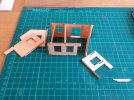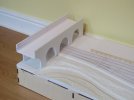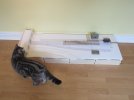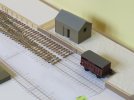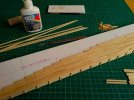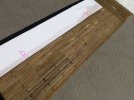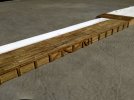2996 Victor
Western Thunderer
Hi everyone,
welcome to my second thread on WT!
Great Bunbury is the second of my recently-started micro layouts, and will Col Stephens-esque light railway set in Shropshire. I'll be aiming for the "newly-minted" look, before all the hopes of the promoters are crushed and decay sets in seriously. I initially considered it as a fictional branch of the Shropshire & Montgomeryshire in the same vein as Ruyton Road, but I'm now leaning more towards a separate completely fictional company which may or may not be part of the good Colonel's empire.
Why Great Bunbury? Well, its a joke name to be honest. Although I'm actually not fond of joke names per se, this is a little nod to Oscar Wilde's "The Importance of being Earnest". In the play, Ernest's friend Algernon tries to discover where Ernest's country estate is located, asking, "Shropshire is your County, isn't it?" When Ernest denies this, Algernon replies, "I thought not - I've 'Bunbury'd' all over Shropshire several times". Bunbury is an invaluable fictional friend of Algernon's, supposedly a perpetual invalid who always has a relapse whenever Algernon is asked to do something he wishes to avoid doing.
Anyway, the baseboard is a laser-cut ply kit from Grainge & Hodder, this one being one of their standard kits. The overall size of the scenic area is the same as Newton Lane at 1.2m long x 0.4m wide, and of course there is the 0.6m long fiddle yard board which the two layouts will share.
The trackwork has been a major delaying factor in that I want to use a light-section flat-bottomed rail, and as I didn't want to try my hand at point building yet, I outsourced the point work. Plain track I'm going to have a go myself using MicroEngineering Code 55 rail with a mixture of copper-clad and strip wood sleepers. At the moment I'm constructing the basic scenery, so I'll also set myself up with a flat surface and some Templot printouts and have a bash at some points. I really want to include a point with interlaced timbering, as that has a really "light railway" feel to it.
Following a great deal of soul-searching, brought about by the appearance of PECO's bullhead OO track, and given my perpetual slowness at building anything, I decided to go down the OO route in the hope of getting something finished before I get too much older.
Locos will have to be kit-built, and so far I've got RT Models kit for their Manning Wardle Old Class I 0-6-0ST. These Mannings were beloved of Col Stephens and I expect an RT Class K will be along soon. I feel there should be a third loco, probably a hireling from a main line company for which there are a number of candidates!
Now that I'm going down the OO route, the loco roster will be based around suitable RTR offerings, at least in the shorter term. This approach will help to factor out another variable in getting something running: my ability or otherwise to build a square chassis! If and when I do get round to building locos, I can think again about track gauge. Rolling stock will be largely kit built, and although I haven't decided on the sources yet there may be a CamRys flavour.
Here is a pic of the baseboard amid the detritus of my hobby room, with the core of the platform and the Templot track print out:
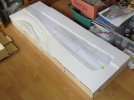
As you can see, it couldn't be a lot simpler! The track "bed" is built up from layers of 5mm foam board, as is the basic platform. The platform itself is on two levels such as could be found on the Shropshire & Montgomeryshire, the passenger bit being lower. There will be a cattle pen and maybe a small goods store on the raised section of the platform, with a carriage loading dock at the end. This accounts for the "reversed" engine release. A small goods shed will be on the single siding
The "landscaped" bit at the left-hand end at the front will become a small, reedy river bed. There maybe two or three willows on its banks to help disguise the scenic break, which will be an abandoned canal aqueduct, partly washed away by the river at some time when it was in spate. The aqueduct will be inspired by the Vyrnwy Aqueduct on the Montgomeryshire Canal; this canal had dreadful problems with its aqueducts as they were built on soft ground and were prone to failing and even collapse. I've been doing a bit of research into canal structures, and its fascinating how the engineers attempted to overcome the difficulties they faced with the technology available to them.
Not much to look at as yet, but hopefully there'll be something interesting happening soon!
Cheers for now,
Mark
EDIT - to reflect change from EM to OO
welcome to my second thread on WT!
Great Bunbury is the second of my recently-started micro layouts, and will Col Stephens-esque light railway set in Shropshire. I'll be aiming for the "newly-minted" look, before all the hopes of the promoters are crushed and decay sets in seriously. I initially considered it as a fictional branch of the Shropshire & Montgomeryshire in the same vein as Ruyton Road, but I'm now leaning more towards a separate completely fictional company which may or may not be part of the good Colonel's empire.
Why Great Bunbury? Well, its a joke name to be honest. Although I'm actually not fond of joke names per se, this is a little nod to Oscar Wilde's "The Importance of being Earnest". In the play, Ernest's friend Algernon tries to discover where Ernest's country estate is located, asking, "Shropshire is your County, isn't it?" When Ernest denies this, Algernon replies, "I thought not - I've 'Bunbury'd' all over Shropshire several times". Bunbury is an invaluable fictional friend of Algernon's, supposedly a perpetual invalid who always has a relapse whenever Algernon is asked to do something he wishes to avoid doing.
Anyway, the baseboard is a laser-cut ply kit from Grainge & Hodder, this one being one of their standard kits. The overall size of the scenic area is the same as Newton Lane at 1.2m long x 0.4m wide, and of course there is the 0.6m long fiddle yard board which the two layouts will share.
Following a great deal of soul-searching, brought about by the appearance of PECO's bullhead OO track, and given my perpetual slowness at building anything, I decided to go down the OO route in the hope of getting something finished before I get too much older.
Now that I'm going down the OO route, the loco roster will be based around suitable RTR offerings, at least in the shorter term. This approach will help to factor out another variable in getting something running: my ability or otherwise to build a square chassis! If and when I do get round to building locos, I can think again about track gauge. Rolling stock will be largely kit built, and although I haven't decided on the sources yet there may be a CamRys flavour.
Here is a pic of the baseboard amid the detritus of my hobby room, with the core of the platform and the Templot track print out:

As you can see, it couldn't be a lot simpler! The track "bed" is built up from layers of 5mm foam board, as is the basic platform. The platform itself is on two levels such as could be found on the Shropshire & Montgomeryshire, the passenger bit being lower. There will be a cattle pen and maybe a small goods store on the raised section of the platform, with a carriage loading dock at the end. This accounts for the "reversed" engine release. A small goods shed will be on the single siding
The "landscaped" bit at the left-hand end at the front will become a small, reedy river bed. There maybe two or three willows on its banks to help disguise the scenic break, which will be an abandoned canal aqueduct, partly washed away by the river at some time when it was in spate. The aqueduct will be inspired by the Vyrnwy Aqueduct on the Montgomeryshire Canal; this canal had dreadful problems with its aqueducts as they were built on soft ground and were prone to failing and even collapse. I've been doing a bit of research into canal structures, and its fascinating how the engineers attempted to overcome the difficulties they faced with the technology available to them.
Not much to look at as yet, but hopefully there'll be something interesting happening soon!
Cheers for now,
Mark
EDIT - to reflect change from EM to OO
Last edited:




 it's a light railway so (almost) anything goes.....
it's a light railway so (almost) anything goes.....
